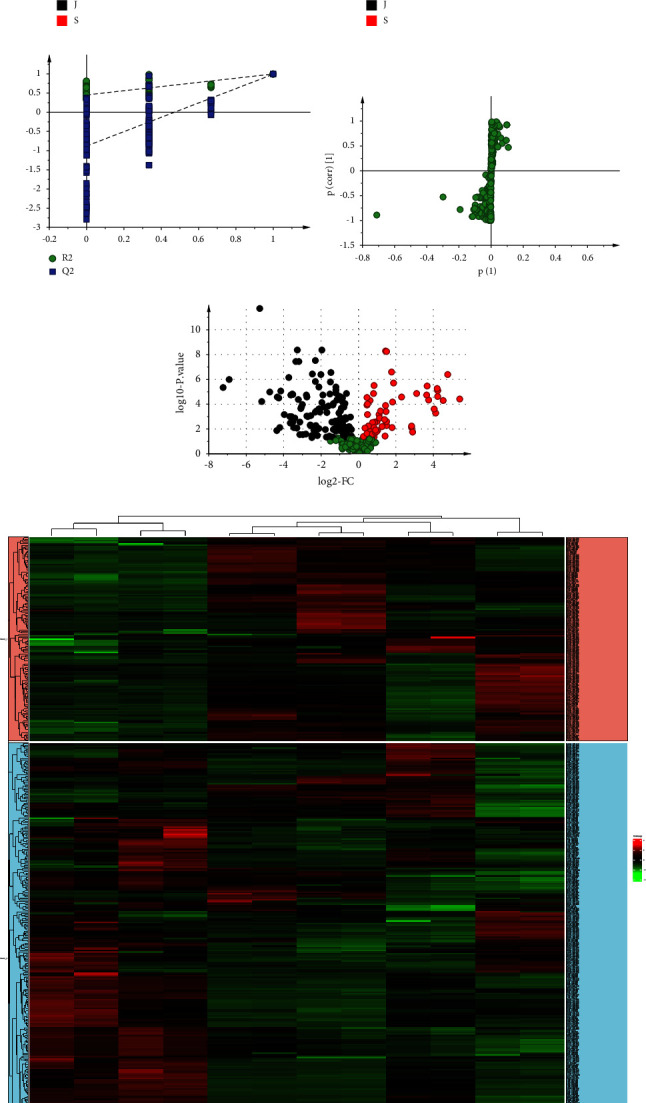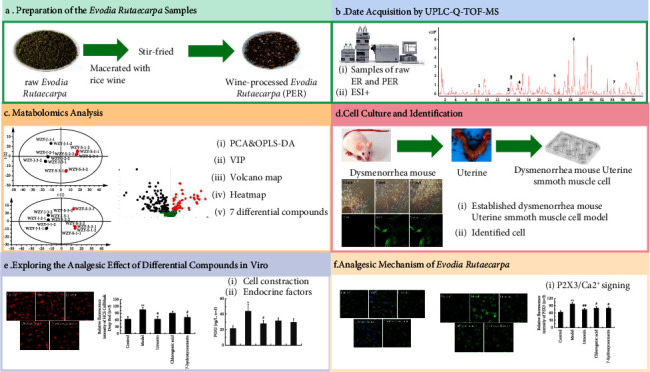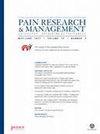枸杞子生、酒对痛经小鼠平滑肌细胞的作用机制及药效物质基础。
IF 2.5
3区 医学
Q2 CLINICAL NEUROLOGY
引用次数: 1
摘要
目的:吴茱萸(ER)是一种著名的中药,用于镇痛痛经、头痛、腹痛等。值得注意的是,酒炙的吴茱萸(PER)的镇痛作用比生的吴茱萸更强。本研究旨在探讨生ER和PER对痛经小鼠平滑肌细胞的作用机制和药效学物质基础。方法:采用基于UPLC-Q-TOF-MS的代谢组学方法,分析葡萄酒加工前后ER的差异成分。然后分别从痛经小鼠和正常小鼠的子宫组织中分离子宫平滑肌细胞。将离体痛经子宫平滑肌细胞随机分为4组:模型组、7-羟基香豆素组(1 mmol/L)、绿原酸组(1 mmol/L)、柠檬素组(50 μmol/L)。正常组取离体正常小鼠子宫平滑肌细胞,每组重复3次。采用免疫荧光染色和激光共聚焦法检测细胞收缩及P2X3、Ca2+的体外表达;采用ELISA法检测7-羟基香豆素、绿原酸和柠檬苦素作用24 h后血清中PGE2、ET-1和NO含量。结果:代谢组学分析结果表明,从粗ER和PER提取物中鉴定出绿原酸、7-羟基香豆素、羟基evolodiamine、laudanosine、evollionines A、limonin和1-甲基-2-[(z)-4-壬烯基]-4 (1H)-喹诺酮等7种差异化合物。体外实验结果显示,7-羟基香豆素、绿原酸和柠檬素均能抑制痛经小鼠子宫平滑肌细胞的细胞收缩,抑制PGE2、ET-1、P2X3和Ca2+,增加NO含量。结论:我们的研究结果表明,PER的化合物与生ER不同,7-羟基香豆素、绿原酸和柠檬苦素可以改善受内分泌因子和P2X3-Ca2+途径封闭的子宫平滑肌细胞收缩小鼠的痛经。本文章由计算机程序翻译,如有差异,请以英文原文为准。



Mechanism and Pharmacodynamic Substance Basis of Raw and Wine-Processed Evodia rutaecarpa on Smooth Muscle Cells of Dysmenorrhea Mice.
Objectives Evodia rutaecarpa (ER) is a well-known herbal Chinese medicine traditionally used for analgesia in dysmenorrhea, headaches, abdominal pain, etc. Notably, the analgesic effect of wine-processed Evodia rutaecarpa (PER) was more potent than that of raw ER. This research aimed to investigate the mechanism and pharmacodynamic substance basis of raw ER and PER on smooth muscle cells of dysmenorrhea mice. Methods Metabolomics methods based on UPLC-Q-TOF-MS were utilized to analyse the differential components of ER before and after wine processing. Afterwards, the uterine smooth muscle cells were isolated from the uterine tissue of dysmenorrhea and normal mice. The isolated dysmenorrhea uterine smooth muscle cells were randomly divided into four groups: model group, 7-hydroxycoumarin group (1 mmol/L), chlorogenic acid (1 mmol/L), and limonin (50 μmol/L). The normal group consisted of the isolated normal mouse uterine smooth muscle cells, which were repeated 3 times in each group. The cell contraction and the expression of P2X3 and Ca2+ in vitro were determined using immunofluorescence staining and laser confocal; ELISA was used for detection of PGE2, ET-1, and NO content after 7-hydroxycoumarin, chlorogenic acid, and limonin administered for 24 h. Results The metabolomics results suggested that seven differential compounds were identified in the extracts of raw ER and PER, including chlorogenic acid, 7-hydroxycoumarin, hydroxy evodiamine, laudanosine, evollionines A, limonin, and 1-methyl-2-[(z)-4-nonenyl]-4 (1H)-quinolone. The in vitro results showed that 7-hydroxycoumarin, chlorogenic acid, and limonin were able to inhibit cell contraction and PGE2, ET-1, P2X3, and Ca2+ in dysmenorrhea mouse uterine smooth muscle cells and increase the content of NO. Conclusion Our finding suggested that the compounds of the PER were different from those of the raw ER, and 7-hydroxycoumarin, chlorogenic acid, and limonin could improve dysmenorrhea in mice whose uterine smooth muscle cell contraction was closed with endocrine factors and P2X3-Ca2+ pathway.
求助全文
通过发布文献求助,成功后即可免费获取论文全文。
去求助
来源期刊

Pain Research & Management
CLINICAL NEUROLOGY-
CiteScore
5.30
自引率
0.00%
发文量
109
审稿时长
>12 weeks
期刊介绍:
Pain Research and Management is a peer-reviewed, Open Access journal that publishes original research articles, review articles, and clinical studies in all areas of pain management.
The most recent Impact Factor for Pain Research and Management is 1.685 according to the 2015 Journal Citation Reports released by Thomson Reuters in 2016.
 求助内容:
求助内容: 应助结果提醒方式:
应助结果提醒方式:


